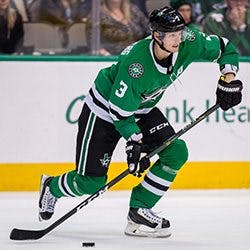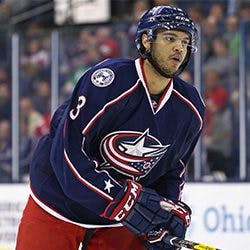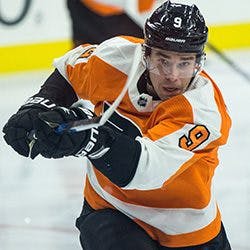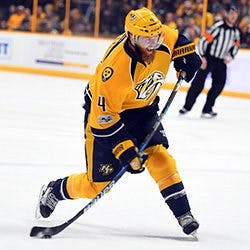Ranking Fantasy Hockey Defensemen By Tiers (1-5)


These tier posts breakdown our positional rankings to help you better understand who you should be targeting in your fantasy draft and when you should be going after them. Here are our top defensemen for the 2018-19 season, starting with tiers 1-5. You can find the rest of our positional tiers here:
- Centre, Tiers 1-5
- Centre, Tiers 6-9
- Right Wing, Tiers 1-5
- Right Wing, Tiers 6-9
- Left Wing, Tiers 1-5
- Left Wing, Tiers 6-9
Tier 1
Brent Burns (SJS), Erik Karlsson (OTT)

Tier 2
Victor Hedman (TBL), John Klingberg (DAL), P.K. Subban (NSH), Roman Josi (NSH), John Carlson (WSH)

Josi notched 14 goals and 39 assists in 2017-18, making it the fourth straight season in which he’s posted double-digit goals and at least 49 points. He could have a monster year if he can build on the career-high 253 shots on goal he registered last season. The biggest knock on Josi’s value heading into the year is his teammate P.K. Subban, who has taken over as the Predator’s quarterback on the powerplay. Subban posted career highs in goals (16) and shots last year (207). The extra powerplay time was enough to revitalize his assist totals, and, assuming their roles remain the same this season, gives him a slight edge over Josi on draft day.
Carlson is coming off a career year last season, having set career-highs in goals (15), assists (53), and shots on goal (237). His above average on-ice shooting percentage and lofty powerplay production will be tough to replicate, however, which is why he sits at the bottom of our second tier heading into this season.
Tier 3
Dustin Byfuglien (WPG), Kris Letang (PIT), Shayne Gostisbehere (PHI), Tyson Barrie (COL), Drew Doughty (LAK), Seth Jones (WPG)

After a troubling 2016-17 season, Gostisbehere tapped into the potential he flashed in his 17-goal rookie season. Most encouragingly is that he was able to do it this time through an abundance of shots rather than shooting at an unsustainable percentage. His 221 shots on goal last season came with an ATOI of just 21:27, suggesting he hasn’t reached peak production just yet. If we weren’t so skeptical of the Flyers’ powerplay being able to replicate the success they had a year ago he’d be much higher on our rankings. Like Gostisbehere, Barrie also bounced back from an off-year in 2016-17, posting career highs in goals (14) and assists (43) last season. His speed and puck handling abilities make him the perfect complement to the Nathan Mackinnon line, and any regression coming to Barrie and the Avalanche might be offset by a rise in his ATOI (22:42 last year).
Doughty is coming off a career-best 60 points and 50 assists last season. A high on-ice shooting percentage suggests his assist totals will regress back towards his career average of 34, but his consistency is enough to keep him slotted into our third tier. Doughty has remarkably played 82 games in each of the last four seasons despite averaging over 28 minutes a night. His floor is as solid as any defenseman in the league, but his ceiling doesn’t go much higher than the 60-point effort he posted a year ago. Jones registered 249 shots last season, 92 more than his previous career high of 157. The uptick in shot volume led to a career year with personal bests in goals (16) and assists (41). Jones looks to be a safe bet to hit 50 points again this year, but his value could take a serious blow if the rumoured departure of Artemi Panarin comes to fruition.
Tier 4
Torey Krug (BOS), Alex Pietrangelo (STL), Ivan Provorov (PHI), Keith Yandle (FLA), Oliver Ekman-Larsson (ARZ)

Coming off 17 goals and 203 shots last season, the sky is the limit for Ivan Provorov. Those are otherworldly numbers for a 21-year-old defenseman, but an 8.4% shooting percentage means his shot volume needs to continue to increase if he wants to build on last year’s totals. He has the potential to lead all NHL defensemen in goals, but a shaky floor prevents him from climbing any further up our rankings.
Yandle is fresh off his best year as a Panther, putting up 8 goals and 48 assists in a full 82 games. He should have no problem churning out a repeat performance as long as he holds down his role on the Panthers’ top powerplay unit. Having not posted double-digit goals since the 2012-13 season, Yandle doesn’t score enough goals to warrant anything more than a mid-round pick. Since the start of the 2013-14 season, Ekman-Larsson is second in NHL defensemen in goals scored (85), behind only Brent Burns (107). He’s as reliable a goal-scorer as any from the blueline and his assist totals could rise above mediocrity as the Coyotes’ young group of forwards continue to improve. Unfortunately, playing for Arizona means those in standard fantasy leagues will likely have to endure another -25 season from OEL.
Tier 5
Zach Werenski (CBJ), Dougie Hamilton (CGY), Morgan Rielly (TOR), Ryan Ellis (NSH), Matt Dumba (MIN)

Rielly went off for 46 assists and 52 points last season, 19 and 16 more than his previous career highs, respectively. He was finally given a decent run of powerplay time last season and he made the most of it, picking up 24 assists with the man advantage. Rielly played just 21 minutes a night last season, a number that could definitely rise given the Leafs’ lack of options on the blueline. Plenty of touts are excited about Ellis heading into this season, which makes sense if you consider the 32 points he put up in just 44 games last season. His 10.5% on-ice shooting percentage points towards some regression, however, and he won’t be leapfrogging Josi or Subban in terms of powerplay time anytime soon.
Dumba enjoyed a breakout campaign in 2017-18, piling up 14 goals and 36 assists. A plethora of injuries on the Wild blueline gave way to a spike in Dumba’s ice time, but he’ll presumably be back behind both Ryan Suter and Jared Spurgeon in ice time once the season gets underway. That combined with his 11.5% on-ice shooting percentage hints towards some regression coming Dumba’s way, but 45 points is still well within reason.